本文翻译自国外论坛 medium,原文地址:本文翻译自国外论坛 medium,原文地址:https://medium.com/deno-the-complete-reference/spring-boot-vs-spring-webflux-performance-comparison-for-hello-world-case-386da4e9c418
如果你已经使用 Spring 一段时间或者是编程初学者,你一定听说过使用响应式编程比传统的线程池风格更好。
自 Spring 诞生以来,开发者创建 Java 企业应用程序就变得更加容易。它提供了在企业环境中使用 Java 语言所需的一切,支持 Groovy 和 Kotlin 作为 JVM 上的替代语言,并且可以根据应用程序的需求灵活地创建多种架构。
在 Spring 4.0 以前,Spring 框架中包含的原始 Web 框架是 Spring Web MVC,它是专门为 Servlet API 和 Servlet 容器构建的。响应式 Web 框架 Spring WebFlux 是在 5.0 版本中添加的。它是完全非阻塞的,支持 Reactive Streams 背压,运行在 Netty、Undertow、Servlet 容器等服务器上。
这两个 Web 框架名称相似(spring-webmvc 和 spring-webflux),并在 Spring 框架中并存。每个模块都是可选的。应用程序可以使用其中一个模块,或者在某些情况下,同时使用两者,例如在 Spring MVC 控制器中可以使用带有响应式编程功能的 WebClient 对象。
本文将给大家介绍使用响应式编程带来的潜在性能优势。我将使用一个简单的 hello world 案例。
测试设置
配置
测试在一台 16G 内存的 MacBook Pro M1 上执行。
软件版本如下:
- Go 1.20.2
- Spring Boot 3.0.5
- Java 17
Spring MVC 与 Spring Webflux 的两种测试总共执行 500 万个请求。
代码
Spring MVC 与 Spring Webflux 的 hello world 代码如下:
Spring Boot
传统的 Spring Boot 项目,单个 Java 文件,
package com.example.demo;
import org.springframework.boot.SpringApplication;
import org.springframework.boot.autoconfigure.SpringBootApplication;
import org.springframework.web.bind.annotation.GetMapping;
import org.springframework.http.ResponseEntity;
import org.springframework.http.HttpStatus;
import org.springframework.web.bind.annotation.RestController;
@SpringBootApplication
@RestController
public class DemoApplication {
public static void main(String[] args) {
SpringApplication.run(DemoApplication.class, args);
}
@GetMapping("/")
public String handleRequest() {
return "Hello World!";
}
}Spring Webflux
与传统的 Spring Boot 项目不同,Spring Webflux 至少需要四个 Java 文件。代码如下,
package hello;
import org.springframework.http.MediaType;
import org.springframework.stereotype.Component;
import org.springframework.web.reactive.function.BodyInserters;
import org.springframework.web.reactive.function.server.ServerRequest;
import org.springframework.web.reactive.function.server.ServerResponse;
import reactor.core.publisher.Mono;
@Component
public class HelloWorldHandler {
public Mono<ServerResponse> hello(ServerRequest request) {
return ServerResponse.ok().contentType(MediaType.TEXT_PLAIN)
.body(BodyInserters.fromValue("Hello World!"));
}
}HelloWorldRouter.java
package hello;
import org.springframework.context.annotation.Bean;
import org.springframework.context.annotation.Configuration;
import org.springframework.http.MediaType;
import org.springframework.web.reactive.function.server.RouterFunction;
import org.springframework.web.reactive.function.server.RouterFunctions;
import org.springframework.web.reactive.function.server.ServerResponse;
import static org.springframework.web.reactive.function.server.RequestPredicates.GET;
import static org.springframework.web.reactive.function.server.RequestPredicates.accept;
@Configuration(proxyBeanMethods = false)
public class HelloWorldRouter {
@Bean
public RouterFunction<ServerResponse> route(HelloWorldHandler helloWorldHandler) {
return RouterFunctions
.route(GET("/"), helloWorldHandler::hello);
}
}HelloWorldClient.java
package hello;
import reactor.core.publisher.Mono;
import org.springframework.http.MediaType;
import org.springframework.stereotype.Component;
import org.springframework.web.reactive.function.client.ClientResponse;
import org.springframework.web.reactive.function.client.WebClient;
@Component
public class HelloWorldClient {
private final WebClient client;
public HelloWorldClient(WebClient.Builder builder) {
this.client = builder.baseUrl("http://localhost:3000").build();
}
public Mono<ClientResponse> getMessage() {
return this.client.get()
.uri("/")
.exchange();
}
}Application.java
package hello;
import org.springframework.boot.SpringApplication;
import org.springframework.boot.autoconfigure.SpringBootApplication;
import org.springframework.context.ConfigurableApplicationContext;
@SpringBootApplication
public class Application {
public static void main(String[] args) {
ConfigurableApplicationContext context = SpringApplication.run(Application.class, args);
HelloWorldClient helloWorldClient = context.getBean(HelloWorldClient.class);
}
}执行
每个测试都接受 500 万个请求执行。
测试中包含 25、100 和 300 个并发测试。
使用 Bombardier HTTP 测试工具进行负载测试。
Bombardier HTTP 是一个用 Go 编写的快速跨平台 HTTP 基准测试命令行工具。
下面是测试结果图表,
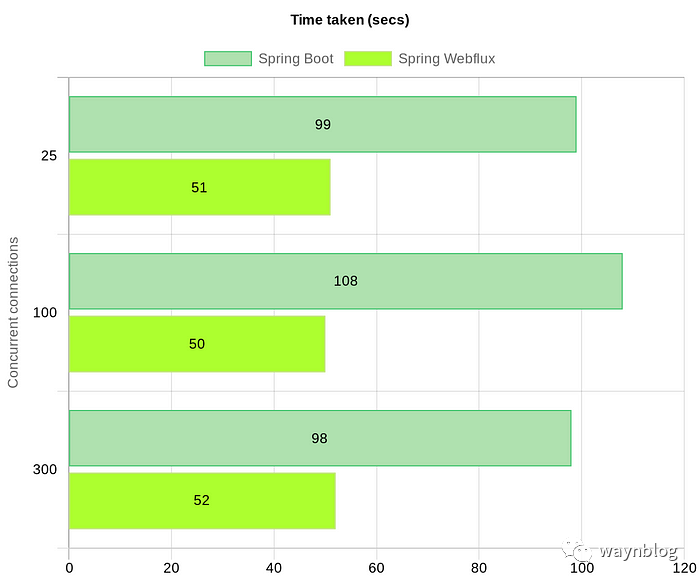 图片
图片
请求耗时,越小越好
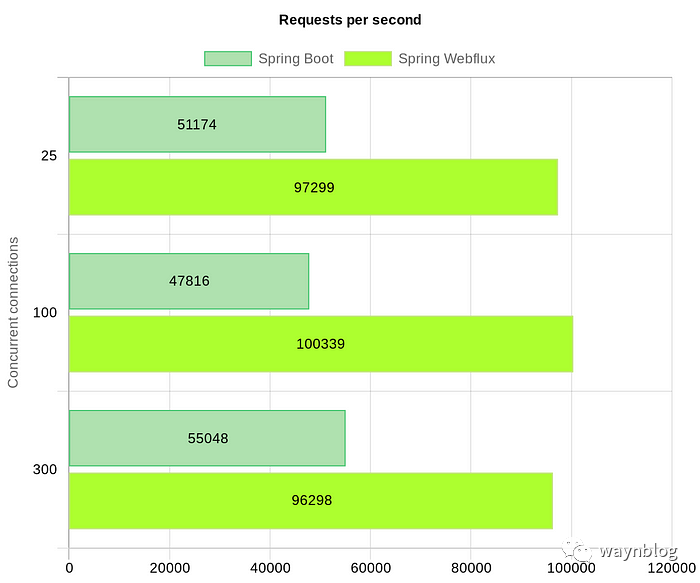 图片
图片
每秒请求数,越大越好
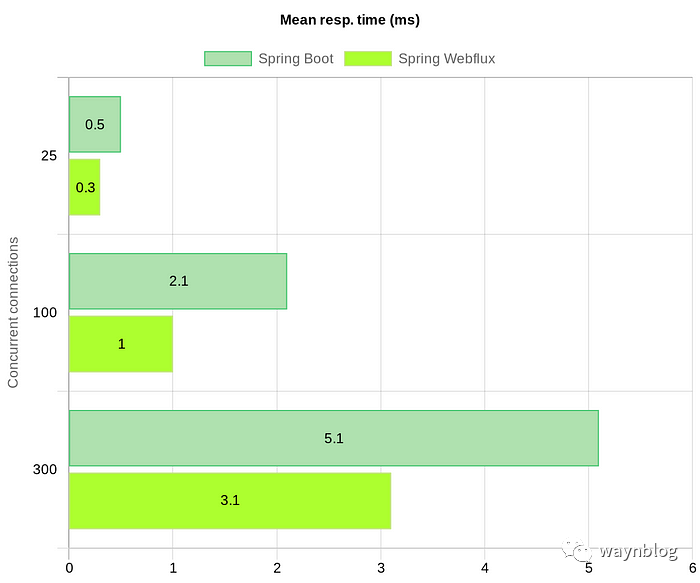 图片
图片
响应时间/ms,越小越好
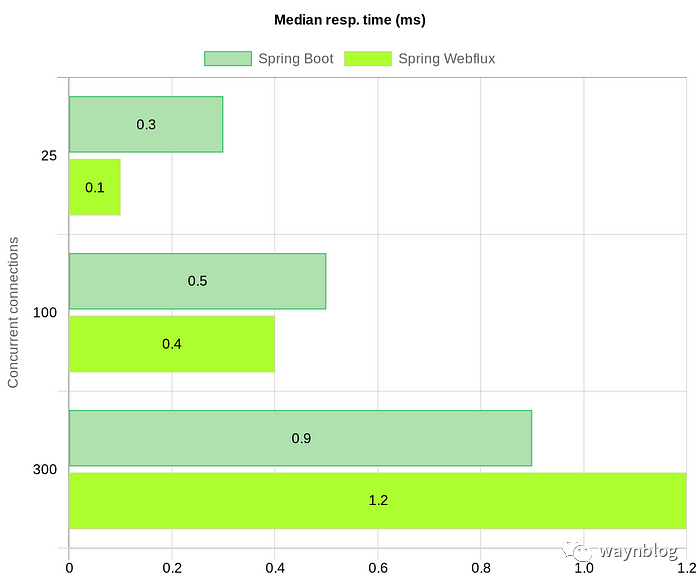 图片
图片
中值响应时间/ms,越小越好
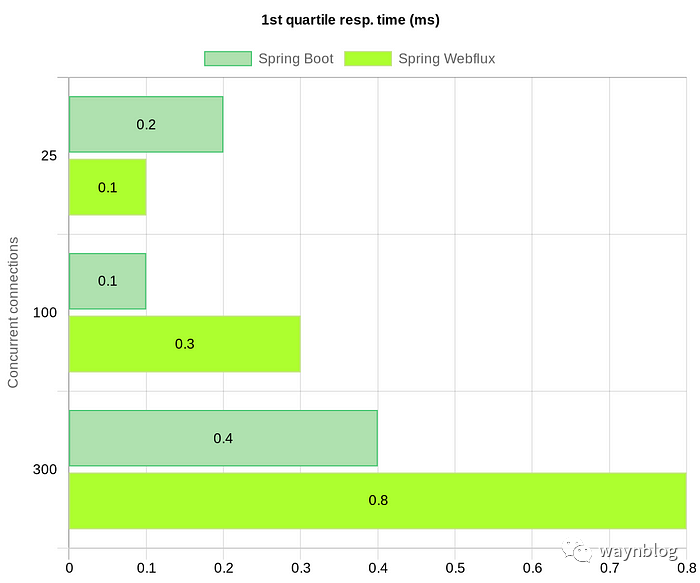 图片
图片
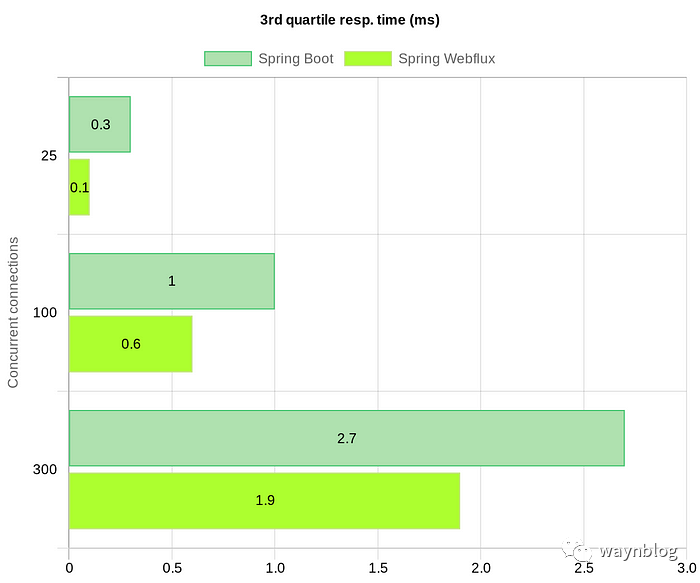 图片
图片
 图片
图片
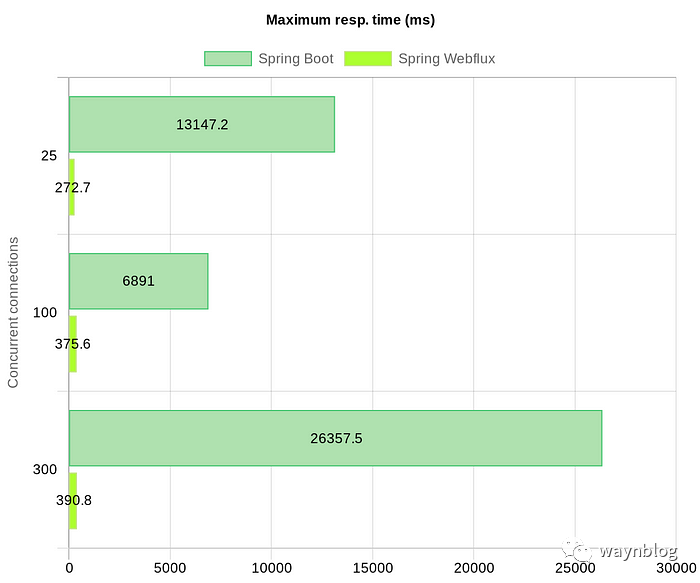 图片
图片
最大响应时间/ms,越小越好
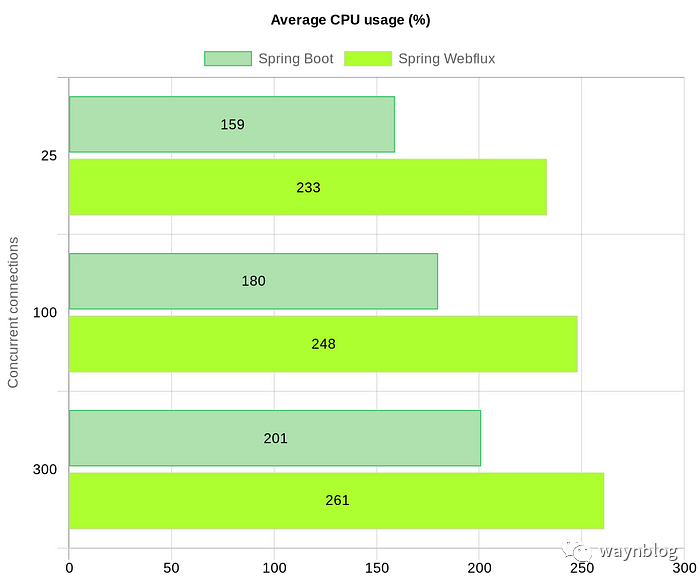 图片
图片
平均CPU占用/%,越小越好
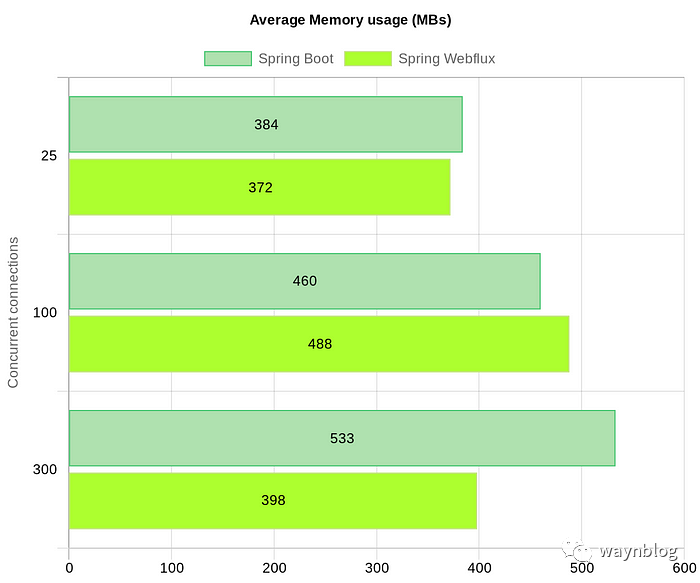 图片
图片
平均内存占用/MBs,越小越好
分析
通过以上结果,很容易得出结论,Spring Webflux(响应式编程)确实比 Spring Boot(线程池)带来了一些显着的性能优势。Spring Webflux 在资源成本相当的情况下提供大约两倍的 RPS。
RPS:指客户端每秒发出的请求数,有些地方也叫做 QPS。
首先由于 Spring MVC 处理这些一次性请求花费的总时间太长,Spring MVC 的平均响应时间并不是那么好。
在低并发情况下,Spring Webflux 的中值响应时间更好。高并发时 Spring Boot 更好。
随着测量值移至第三个四分位和第 90 个百分位,Spring Webflux 变得更好。即使有差异,也只有 1-2 毫秒左右。
最后
我们宣布 Spring MVC 与 Spring Webflux:hello world 性能测试案例的获胜者是 Spring Webflux。




































